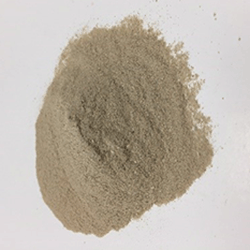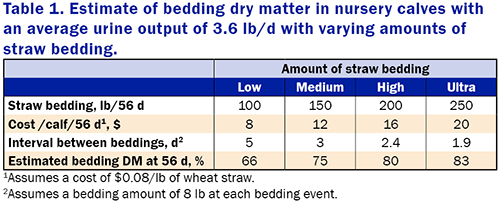
Fast Fact: How Much Bedding Do My Calves Need?
 By Dr. Noah Litherland, Vita Plus dairy youngstock technical specialist
By Dr. Noah Litherland, Vita Plus dairy youngstock technical specialist
Question: How Much Bedding Do My Calves Need?
Answer: Visually evaluate feet, knees and outer thighs of calves daily. If all three areas are clean, the goal of keeping calves clean and dry has been met.
A bit more: Clean and dry calves are a hallmark of elite calf raisers. Bedding management plays an integral role in the health, wellbeing and efficiency of nursery calf growth. Bacteria need moisture to conduct business, so keeping the calf environment dry also helps control the microbial ecology. Bacteria counts in clean straw are typically around 22,000 colony-forming units (cfu) per gram. Once bedding gets wet with urine and manure, the bacteria concentration often exceeds 2 million cfu per gram.
Lying down is an important behavior for dairy calves. Dairy calves spend about 18 hours per day lying down, and some data suggest inadequate lying time reduces growth. British Columbia researchers designed a study to determine the impact of sawdust bedding moisture content on lying time. Calves were offered bedding of 90, 74, 59, 41, and 29 percent dry matter or bare concrete. Calves showed a strong preference toward lying on dry bedding, especially once bedding moisture decreased below 59 percent. Time spent lying decreased with increased moisture as calves discontinued lying on bedding at 29 percent moisture and never chose to lay on bare concrete (Camiloti et al., 2012).
How do I know if my bedding management plan is working?
Visually evaluate feet, knees and outer thighs of calves daily. If all three areas are clean, then the goal of keeping calves clean and dry has been met. Additional factors, such as keeping air ammonia below 10 ppm and providing calves with adequate nesting ability in the bedding, are also important considerations.
Factors influencing bedding needs
Here are five key factors that influence bedding needs for dairy calves:
- Calf size and age: Days on feed is a significant factor impacting bedding needs. As calves grow and age, they consume greater amounts of feed and water, resulting in increased moisture output into the environment, which, of course, has an additive effect over time.
- Nutrition and health: Calves fed an appropriate plane of nutrition are very efficient and, therefore, the loss of nutrients in urine and feces is decreased. Calves fed excessive protein relative to their requirements will have decreased fecal dry matter (watery fecal consistency) and will produce a greater volume of urine as the kidneys work overtime to eliminate excessive nitrogen from blood.
- The intestinal tract of healthy calves absorbs a large proportion of water from digesta and uses this water as an important component of muscle and bone growth. Calves with loose manure experience a reversal of water flow and calf tissues lose water through the intestines.
- Facility: Bedding requirements vary by housing type (individual versus group). Group housing tends to require greater amounts of bedding versus individual housing. Group housing systems with a porous base or properly sloped and placed drains aid in removing bedding moisture. Drainage design and effectiveness also impact bedding requirements. Calf hutches placed on 4 to 6 inches of sand with straw on top drain extremely well and, as a result, require less straw to keep calves clean and dry.
- When designing or remodeling facilities, consider methods for bedding additions and removal. The method for adding bedding to a facility can be as simple as a pitchfork and a cart or as complex as a large tractor and bedding chopper. Evaluate space requirements for operating bedding machinery, distance of throw, and how calves are going to be penned during bedding in continuous-flow housing systems.
- Spill from drinking fountains and buckets contributes to bedding moisture. Evaluate strategies to decrease water spills by inspecting automatic floats in water fountains, adjusting if water level is too low or high, and selecting pail holders that keep pails in place.
- Environment: Meteorological factors (temperature, humidity, precipitation and wind speed) all impact the rate and extent of moisture in bedding. Additionally, the height of the water table can certainly impact calf bedding due to wicking of ground moisture. Air movement from power ventilation systems and adjusting vents on calf hutches can help with moisture removal from the calf environment.
- Bedding type: Clean wheat straw is the preferred bedding for nursery calves. Type and particle size of bedding certainly impact absorption capacity. Finely processing straw increases absorptive surface area, but also decreases nesting ability of the bedding. Sawdust and wood shavings are acceptable sources of bedding for calves. Corn stalks and soybean stubble hay lack the water-absorbing and insulating capacity of wheat straw and are more appropriately used for heifers over three months of age.
How much bedding is needed?
This should be an easy question to answer, but it is complicated by the coefficient of water absorption of the bedding material, the amount of water draining from the bedding material, and the amount of water lost via evaporation.
According to research at Virginia Tech University, calves fed varying planes of nutrition from milk replacer at 54 days of age produced 2.9 to 9.6 pounds of urine daily and 0.6 to 1.0 pounds of fecal dry matter daily. Let’s do a hypothetical example to see if we can get an idea of bedding dry matter with varying amounts of straw.
If we assume average calf urine output is 3.6 pounds per day, and if straw has a water absorbing capacity of four times its weight, then we can at least estimate what the straw bedding dry matter would be at the end of a 56-day nursery period.
In the example below, bedding moisture at 66 percent using 100 pounds of straw is marginally adequate, according to the British Columbia study. Bedding with medium and high bedding amounts of 150 and 200 pounds of straw through 56 days increases bedding dry matter and calf comfort, but, of course, also increases bedding costs and labor to bed calves with increased frequency. The ultra-bedded calves using 250 pounds of straw (6.25 small square bails weighing 40 pounds each) have a bedding dry matter content above 80 percent.
 Drygiene
Drygiene
A new product may help calf raisers maintain bedding needs. Drygiene™ (shown in photo to right) is an absorbent, antibacterial drying powder used to control humidity, suppress ammonia, and reduce bacteria in livestock facilities. Drygiene can be applied directly to bedding in maternity pens, calf hutches, and group housing pens to help keep facilities clean, dry, and fresh-smelling. Contact your local Vita Plus consultant to learn more.
Summary
Many factors – such as calf age and size, nutrition and health, facility design, environment, and bedding type – all impact the amount of bedding needed for calves. In the example provided, I attempted to estimate the amount of bedding required to keep calves dry, which is in the ballpark of 150 to 200 pounds of straw per calf in a hutch setting. This estimate does not include evaporation or drainage and only evaluates urine output without consideration for fecal output. Adding a drying powder, like Drygiene, increases drying and decreases air ammonia.
| Category: |
Animal health Bedding Business and economics Starting Strong - Calf Care |


